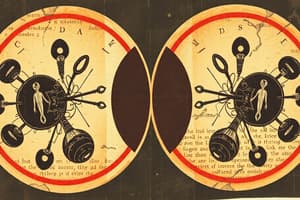Podcast
Questions and Answers
What is the primary purpose of mitosis in organisms?
What is the primary purpose of mitosis in organisms?
- Enhancement of genetic diversity
- Production of gametes
- Growth and tissue repair (correct)
- Asexual reproduction only
Which statement accurately describes meiosis?
Which statement accurately describes meiosis?
- It produces two identical daughter cells.
- It produces four non-identical daughter cells. (correct)
- It is involved in asexual reproduction.
- It occurs only in prokaryotic organisms.
Why are cells considered the basic unit of life?
Why are cells considered the basic unit of life?
- They contain organelles that are identical in all organisms.
- They are the largest structures in organisms.
- They can reproduce without any assistance.
- They can independently carry out essential life processes. (correct)
Which process is NOT a characteristic of life performed by cells?
Which process is NOT a characteristic of life performed by cells?
What role does DNA play in cells?
What role does DNA play in cells?
How do cells respond to environmental changes?
How do cells respond to environmental changes?
Which characteristic is essential for the continuity of life in cells?
Which characteristic is essential for the continuity of life in cells?
What is a result of meiosis in terms of chromosome number?
What is a result of meiosis in terms of chromosome number?
What is the main difference between multicellular and unicellular organisms?
What is the main difference between multicellular and unicellular organisms?
What instrument is essential for viewing unicellular organisms?
What instrument is essential for viewing unicellular organisms?
What does the Cell Theory state regarding living organisms?
What does the Cell Theory state regarding living organisms?
Who were the first to identify that all plants and animals are made of cells?
Who were the first to identify that all plants and animals are made of cells?
Which part of the cell is responsible for carrying out specific functions within the cell?
Which part of the cell is responsible for carrying out specific functions within the cell?
What type of organisms are typically too small to be viewed without a microscope?
What type of organisms are typically too small to be viewed without a microscope?
Which of the following is NOT a characteristic attributed to multicellular organisms?
Which of the following is NOT a characteristic attributed to multicellular organisms?
The invention of which tool was crucial for the discovery of cells?
The invention of which tool was crucial for the discovery of cells?
Study Notes
Mitosis and Meiosis
- Mitosis results in two genetically identical daughter cells, serving functions in growth, tissue repair, and asexual reproduction.
- Meiosis produces four non-identical gametes (sperm, egg cells, or spores), crucial for sexual reproduction and genetic diversity.
The Cell as the Basic Unit of Life
- Cells are the smallest units that perform all life functions, exhibiting characteristics such as structural organization.
- Structural organization includes organelles that perform specific functions like energy production and waste removal.
- Functional independence allows cells to carry out essential processes like metabolism, homeostasis, and reproduction independently.
- Cells contain DNA, which guides development, functioning, and heredity, ensuring trait transmission across generations.
- Cells can reproduce through mitosis and meiosis, allowing for growth and repair.
- Cells respond to environmental stimuli, crucial for survival, adaptation, and maintaining equilibrium.
- Multicellular organisms are macroscopic and visible to the unaided eye, while unicellular organisms are microscopic and require a microscope for observation.
- The microscope magnifies small objects, facilitating the study of cells.
The Cell Theory
- Schleiden and Schwann proposed that all plants and animals are composed of cells, establishing the foundational concept of cell theory.
- Virchow and Remak contributed to the understanding of cell division and its importance in biological processes.
Organelles and Their Functions
- Organelles are specialized structures within the cell that support various processes essential for life.
- Different organelles perform unique functions, including but not limited to energy production, protein synthesis, and cellular communication.
- Examples of organelles include centrioles which play a role in cell division, although specific functions of all organelles were not detailed.
Plant Cell Structure
- Plant cells have unique structures, which differentiate them from animal cells, although detailed characteristics were not provided.
Studying That Suits You
Use AI to generate personalized quizzes and flashcards to suit your learning preferences.
Related Documents
Description
This quiz explores the processes of mitosis and meiosis, fundamental biological processes involved in cell division. Participants will learn the differences between these two types of cell division and their roles in growth, tissue repair, and reproduction. Test your knowledge on how these processes contribute to the life cycle of organisms.




